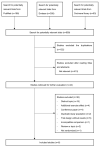Effects of the Short-Foot Exercise on Foot Alignment and Muscle Hypertrophy in Flatfoot Individuals: A Meta-Analysis
- PMID: 36231295
- PMCID: PMC9564534
- DOI: 10.3390/ijerph191911994
Effects of the Short-Foot Exercise on Foot Alignment and Muscle Hypertrophy in Flatfoot Individuals: A Meta-Analysis
Abstract
This study aimed to conduct a meta-analysis of randomized controlled trials to examine the effects of the short-foot exercise (SFE) compared to foot orthosis or other types of interventions. Eligibility criteria involved participants with flatfoot engaging in the SFE compared to other forms of intervention or control groups without specific intervention. Relevant studies published before the end of June 2022 were identified from databases. A meta-analysis was performed by calculating the mean differences (MD) and standard MD (SMD) using the random effects model. Six trials with 201 patients (out of 609 records) that met selection criteria were reviewed. Five of the six trials implemented distinct interventions in the control group such as shoe insoles and muscle strengthening exercises, while in the remaining trial, controls received no intervention. The SFE group significantly reduced the navicular drop test (NDT) values (MD: -0.23; 95% confidence interval: -0.45 to -0.02; p = 0.04) and the foot posture index (FPI-6) score (MD: -0.67; 95% confidence interval: -0.98 to -0.36; p < 0.0001) when compared to the control group. The muscle hypertrophy did not differ significantly between the groups. The SFE may contribute more benefits than other intervention as it affects flatfoot individuals' foot alignment. Hence, the SFE is recommended as a beneficial dynamic support when facing flatfoot problems.
Keywords: exercise; foot posture index; intrinsic foot muscle; navicular drop.
Conflict of interest statement
The authors declare no conflict of interest.
Figures




References
Publication types
MeSH terms
LinkOut - more resources
Full Text Sources
Medical
Miscellaneous

